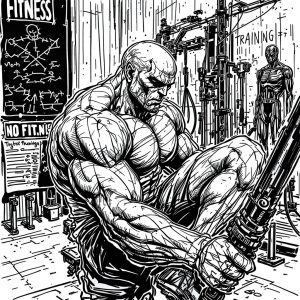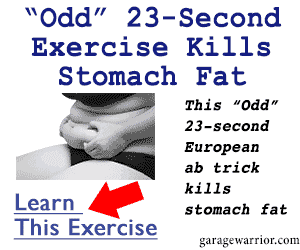Building muscle without a gym is entirely possible, and it can be done effectively with bodyweight exercises, proper nutrition, and consistency. Whether you’re traveling, on a budget, or simply prefer working out at home, this guide will help you build muscle and strength without stepping foot in a gym.

1. Understand the Basics of Muscle Building
To build muscle, you need three key components:
Progressive Overload: Gradually increasing the difficulty of your workouts to challenge your muscles.
Proper Nutrition: Consuming enough protein, calories, and nutrients to support muscle growth.
Rest and Recovery: Allowing your muscles time to repair and grow after workouts.
2. Bodyweight Exercises for Muscle Building
Bodyweight exercises are the foundation of building muscle without a gym. Focus on compound movements that target multiple muscle groups.
Upper Body
Push-Ups: Targets chest, shoulders, and triceps. Variations like diamond push-ups or decline push-ups increase difficulty.
Pull-Ups/Chin-Ups: Works the back, biceps, and shoulders. Use a sturdy bar or tree branch.
Dips: Targets triceps and chest. Use parallel bars or sturdy furniture.
Pike Push-Ups: Focuses on shoulders and triceps, mimicking an overhead press.
Lower Body
Squats: Builds quads, glutes, and hamstrings. Progress to pistol squats (single-leg squats) for more challenge.
Lunges: Targets legs and glutes. Try walking lunges or jumping lunges for intensity.
Glute Bridges: Isolates the glutes and hamstrings. Progress to single-leg bridges.
Calf Raises: Strengthens calves. Do them on stairs for a greater range of motion.
Core/Abdominals
Planks: Builds core stability. Try side planks or plank-to-push-up variations.
Leg Raises: Targets lower abs. Hang from a bar or do them lying on the floor.
Russian Twists: Works obliques. Add weight (like a water bottle) for resistance.
Mountain Climbers: Combines cardio and core strength.
3. Progressive Overload Without Weights
Since you’re not using weights, you’ll need to increase difficulty in other ways:
Increase Reps: Gradually add more repetitions to your sets.
Slow Down Tempo: Perform exercises slower to increase time under tension.
Add Variations: Move to harder versions of exercises (e.g., regular push-ups to archer push-ups).
Use Household Items: Fill a backpack with books for added weight or use water jugs as makeshift dumbbells.
Incorporate Isometric Holds: Pause at the hardest part of the movement (e.g., bottom of a squat) to increase intensity.
4. Create a Workout Plan
A well-structured plan ensures you’re targeting all muscle groups and progressing over time.
Sample Full-Body Routine (3-4 days/week):
1. Warm-Up: 5-10 minutes of dynamic stretches or light cardio (e.g., jumping jacks, high knees).
2. Push-Ups: 3 sets of 8-15 reps.
3. Pull-Ups: 3 sets of 5-10 reps (use assistance if needed).
4. Squats: 3 sets of 10-20 reps.
5. Plank: 3 sets of 30-60 seconds.
6. Lunges: 3 sets of 10-12 reps per leg.
7. Dips: 3 sets of 8-12 reps.
8. Cool-Down: Stretch major muscle groups for 5-10 minutes.
Split Routine Example:
Day 1: Upper Body (Push-Ups, Pull-Ups, Dips, Plank)
Day 2: Lower Body (Squats, Lunges, Glute Bridges, Calf Raises)
Day 3: Core (Leg Raises, Russian Twists, Mountain Climbers, Side Planks)
-Day 4: Rest or Active Recovery (light stretching, walking, or yoga)
5. Nutrition for Muscle Growth
Muscle building requires proper fueling. Focus on:
Protein: Aim for 0.8-1.2 grams of protein per pound of body weight daily. Sources include eggs, chicken, fish, beans, lentils, and Greek yogurt.
Calories: Eat in a slight caloric surplus to support muscle growth. Track your intake if needed.
Carbohydrates: Provide energy for workouts. Include whole grains, fruits, and vegetables.
Fats: Essential for hormone production. Incorporate healthy fats like avocados, nuts, and olive oil.
Hydration: Drink plenty of water to support performance and recovery.
6. Recovery and Rest
Sleep: Aim for 7-9 hours of quality sleep per night. Muscle repair happens during rest.
Active Recovery: Light activities like walking or yoga can improve circulation and reduce soreness.
Stretching: Incorporate stretching or foam rolling to improve flexibility and prevent injury.
7. Track Your Progress
Take Photos: Visual progress can be motivating.
Measure Strength: Track how many reps or sets you can do over time.
Adjust as Needed: If an exercise becomes too easy, increase difficulty or switch to a harder variation.
8. Stay Consistent and Patient
Building muscle takes time, whether you’re in a gym or not. Stay consistent with your workouts, nutrition, and recovery, and you’ll see results.
9. Optional Equipment for Home Workouts
If you want to add variety, consider investing in:
Pull-Up Bar: For upper body strength.
Resistance Bands: Add resistance to bodyweight exercises.
Yoga Mat: For comfort during floor exercises.
Jump Rope: For cardio and conditioning.
By following this guide, you can build muscle effectively without a gym. Remember, the key is consistency, progressive overload, and proper nutrition. Stay motivated, and enjoy the process!

This special report cuts through the noise and reveals the top tips from experienced trainers!>>>Instant Download

